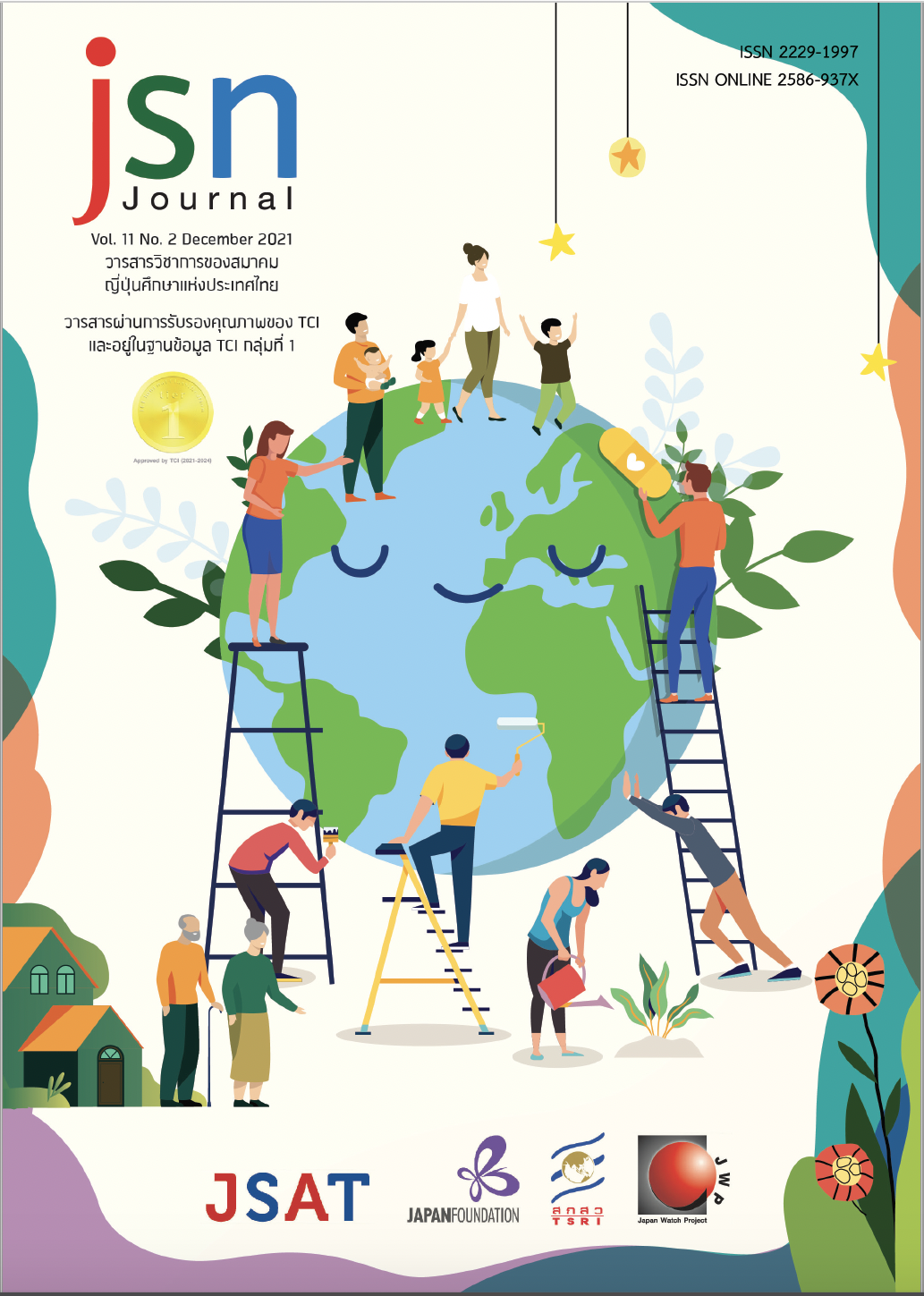ทำไมผู้เรียนชาวไทยฟังภาษาญี่ปุ่นผิด ‘nan-nichi’ เป็น ‘nan-ji’: การศึกษาเปรียบเทียบเสียงพูดภาษาไทยและภาษาญี่ปุ่น
Main Article Content
บทคัดย่อ
การศึกษาครั้งนี้ เพื่อศึกษาวิธีการเปรียบเทียบและตรวจสอบถึงสาเหตุของการฟัง คำว่า 'nan-nichi' (วันที่อะไร) ของผู้เรียนคิดว่าเป็น 'nan-ji' (กี่โมง) ในผู้เรียนชาวไทยที่เรียนในสาขาภาษาญี่ปุ่น ระดับชั้นปีที่สอง จากสถาบันปัญญาภิวัฒน์ มีความผิดพลาดในการฟังบ่อยครั้ง เหตุใดผู้เรียนจึงพบว่าการแยกคำสองคำนี้เป็นเรื่องยากและเพื่อหลีกเลี่ยงการสื่อสารที่ผิดพลาดของผู้เรียน ผู้วิจัยได้ตั้งสมมติฐานเพื่อชี้แจงประเด็นนี้ โดยสันนิษฐานว่า ตามปกติแล้วเสียงธนิตจะมีการปล่อยลม chi /tɕʰ/ ออกมา อย่างไรก็ตาม ถ้าเสียงธนิต/tɕi/อยู่ในตำแหน่งระหว่างเสียงสระของคำทั่วไป เสียงธนิตจะถูกลดการปล่อยลมและเสียง [tɕi] ทำให้ผู้เรียนชาวไทยเข้าใจว่าเป็นเสียงสิถิล ji ผลการศึกษานี้คือ 1) เสียงธนิตจะถูกลดการปล่อยลมและเสียง ทำให้ผู้เรียนชาวไทยเข้าใจว่าเป็นเสียงสิถิล 2) เสียงธนิตและเสียงสิถิลเป็นหน่วยเสียงเดียวกันสำหรับชาวญี่ปุ่น แต่เป็นเสียงที่แตกต่างกันสำหรับผู้เรียนชาวไทย ผลการศกึษานี้ ไม่เพียงแต่จะเป็นประโยชน์สำหรับผู้เรียนชาวไทยเท่านั้น แต่ยังเป็นประโยชน์สำหรับครูผู้สอนภาษาญี่ปุ่นสำหรับคนไทยอีกด้วย
Article Details

อนุญาตภายใต้เงื่อนไข Creative Commons Attribution-NonCommercial-NoDerivatives 4.0 International License.
ข้อความและข้อคิดเห็นต่างๆ ในบทความเป็นของผู้เขียนบทความนั้นๆ ไม่ใช่ความเห็นของกองบรรณาธิการหรือของวารสาร jsn Journal
เอกสารอ้างอิง
References
อัษฎายุทธ ชูศรี. (2020). แปดประเด็นภาษาศาสตร์ภาษาญี่ปุ่นเบื้องต้น. กรุงเทพ: โครงการเผยแพร่อักษรศออักษรศผลงานวิชาการคณะอักษรศาตจุฬาลงกรณ์มหาวิทยาลัย.
ประกาศสํานักนายกรัฐมนตรี. (2561).หลักเกณฑ์การทับศัพท์ภาษาเยอรมัน สเปน ญี่ปุ่น และมลายู (น. 69-78ออักษรศเล่ม 135 ตอนพิเศษ 82 ง). กรุงเทพฯ : ราชกิจจานุเบกษา.
Banchongmanee, Bussaba. Wutthichamnong, Wattana. Tomorakun, Wilai. Hideo Maruyama อักษรศ(2009).『場面で役立つ使えるタイ語』. กรุงเทพฯ : สำนักพิมพ์ภาษาและวัฒนธรรม สมาคมอักษรศส่งเสริมเทคโนโลยี (ไทย-ญี่ปุ่น).
Crystal, D. (2000). The Cambridge Encyclopedia of Language, second edition. C.U.P.
星野珠美, 安田明生 (2002). 「日本人学生による中国語有気発話のVOTとパワーによる評価」
『日本音響学会誌』11 : 689-695
五十島優. 酒井たか子. 平形裕紀子 (2001). 「学習者にとって聞き取りが困難な話し言葉の音変化อักษรศとは」『日本語教育方法研究会誌語』8:26-27.
金珠 (2019). 「日本語の語頭・語中破裂音のVOTに関する考察 」『日本語・日本文化』 46: อักษรศ47-69.
曺秀弦 (2016). 「韓国人学習者による日本語破擦音の音声的特徴について」『音声研究』20:58 อักษรศ–67.
苅安誠. 太田栄次. SNYDER Steven M. (2007).「日本語と英語・中国語との音声学的特徴と相อักษรศ違点:第二言語学習の壁を理解するために」『九州保健福祉大学研究紀要』 8:133-อักษรศ138.
李敬淑 (2013). 「韓国語母語話者による日本語発音の聞き間違いと中間言語の音韻習得」อักษรศ『日本文化學報』59:65-79. 10:511-530.
林嘉恵 (2001). 「台湾人日本語学習者が破裂音を聞き取る際の問題点について 」『言語文化อักษรศと日本語教育』 21: 140-143.
丸山秀夫 (2008).『発見タイ語発音 : 日本語から学ぶ9つのポイント』. กรุงเทพฯ : สำนักพิมพ์อักษรศอักษรศภาษาและวัฒนธรรม สมาคมส่งเสริมเทคโนโลยี (ไทย-ญี่ปุ่น).
南條健助 (1999). 「異音: 音韻論と音声学の接点」『音声研究』 3: 20-28.
大木俊英.、前田啓貴、岡秀亮 (2016).「何が英語のリスニングを困難にするのか?」『白鳳อักษรศ大学教育学部論集』59:65-79. 10:511-530.
Slayden, G. (2009). Central Thai Phonology. retrieved 2021, November 9 from
อักษรศhttp://www.thai-language.com/resources/slayden-thai-phonology.pdf
高橋栄作 (2005).「日本人EFL学習者の聞き間違い」『地域政策研究』8:45-53.
宇都木 昭 (2009).「日本語と朝鮮語の破裂音― 音響音声学的研究の概 観 ―」『北海道言語อักษรศ文化研究』7:11-27.
吉廣綾子 (2004).日本語の無声子音・有声子音、中国語の有気音・無気音の比較」『徳島大学国語
国文学』17:1-13.
鄒亜亨. 柏木治美. 大月一弘. 康敏 (2012).「リスニング学習履歴データに基づく誤りパターンกษรศの検出システム」『日本教育工学会論文誌』 36:49-52.


